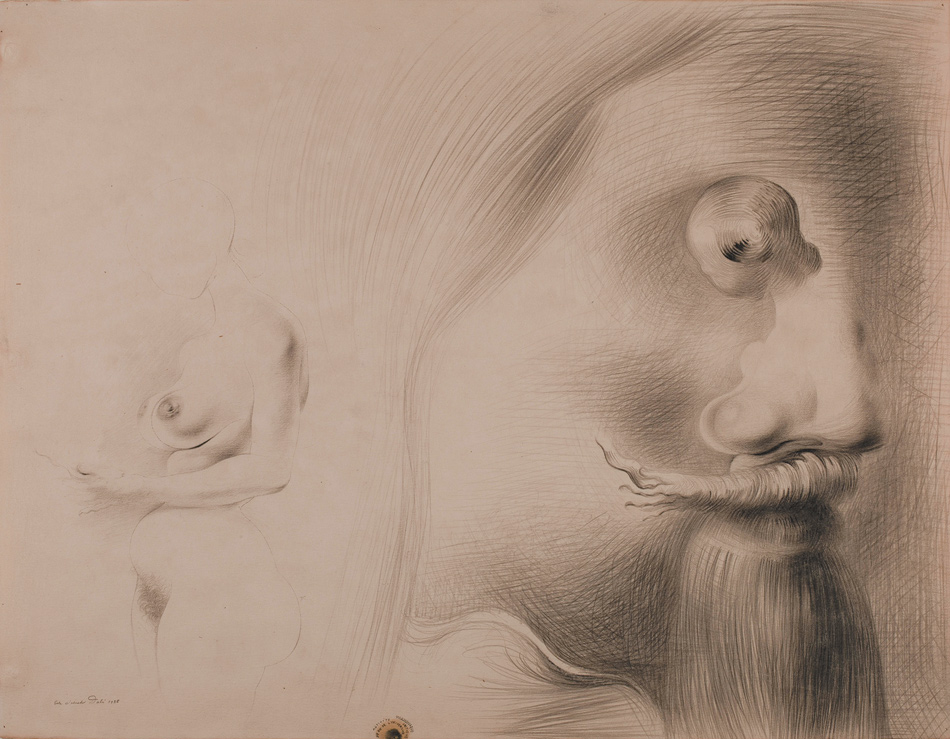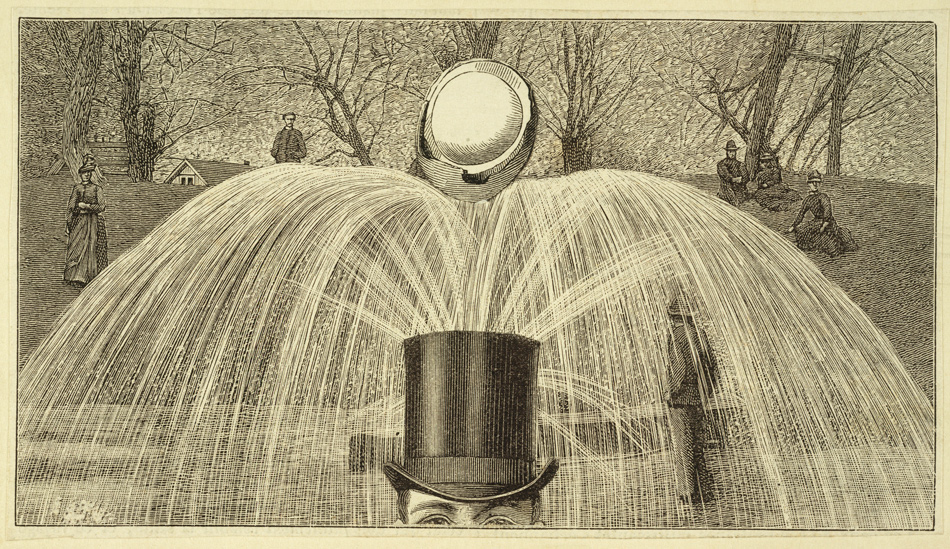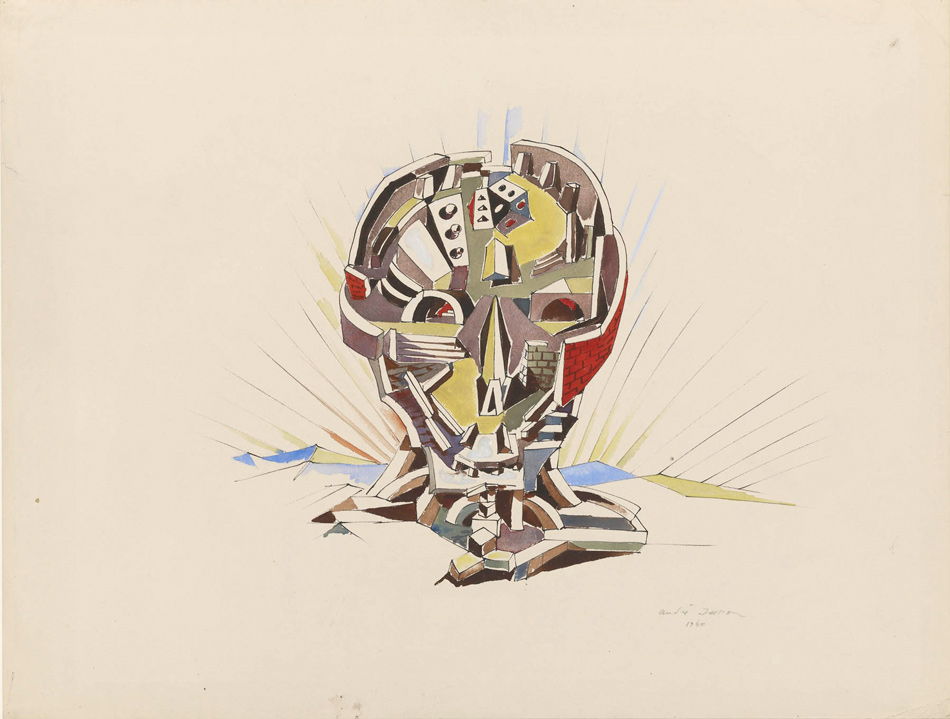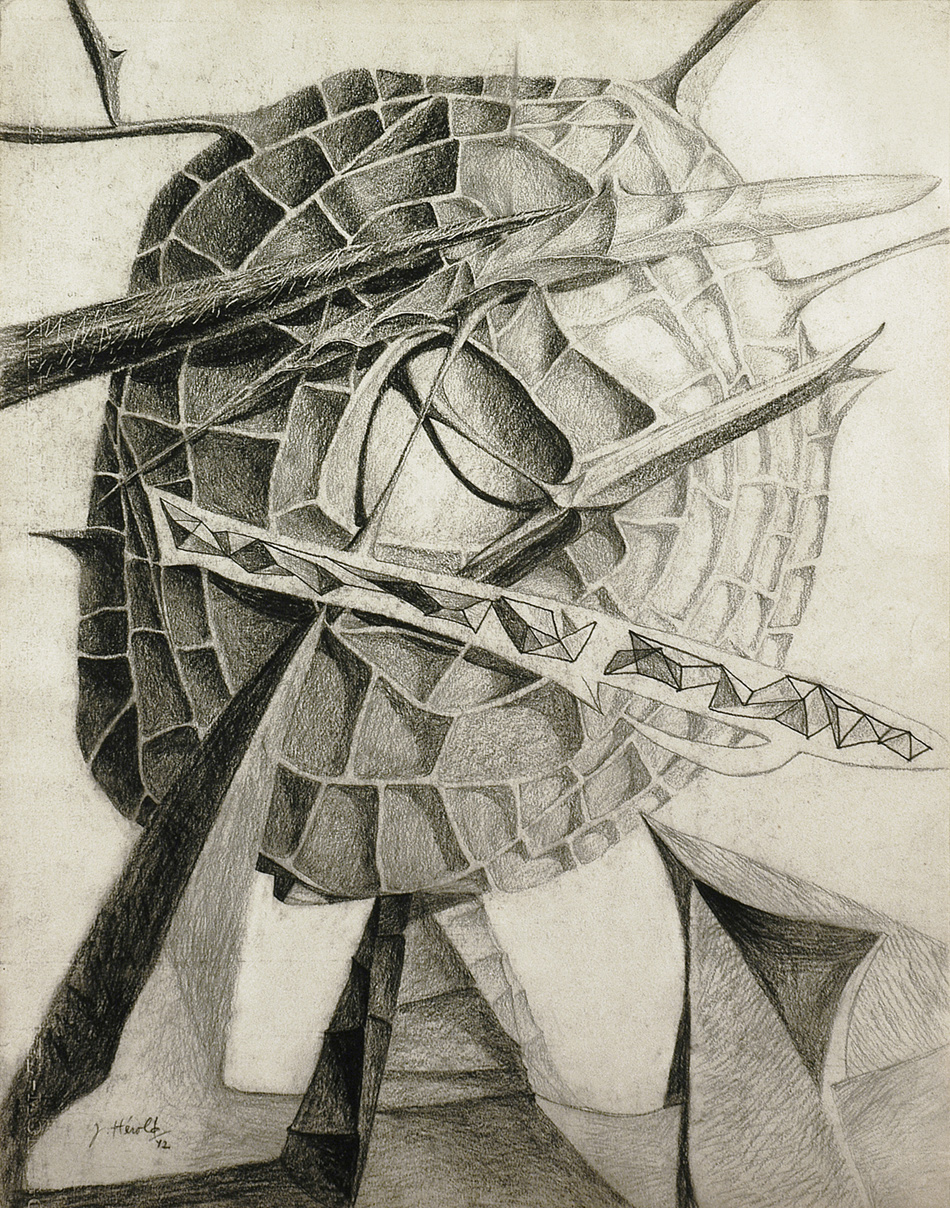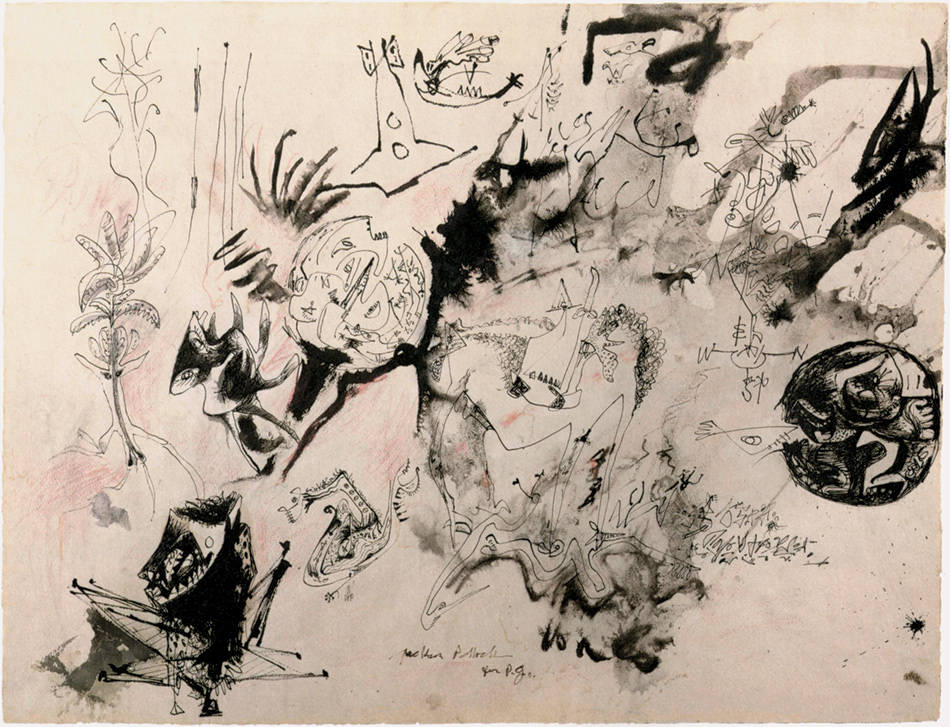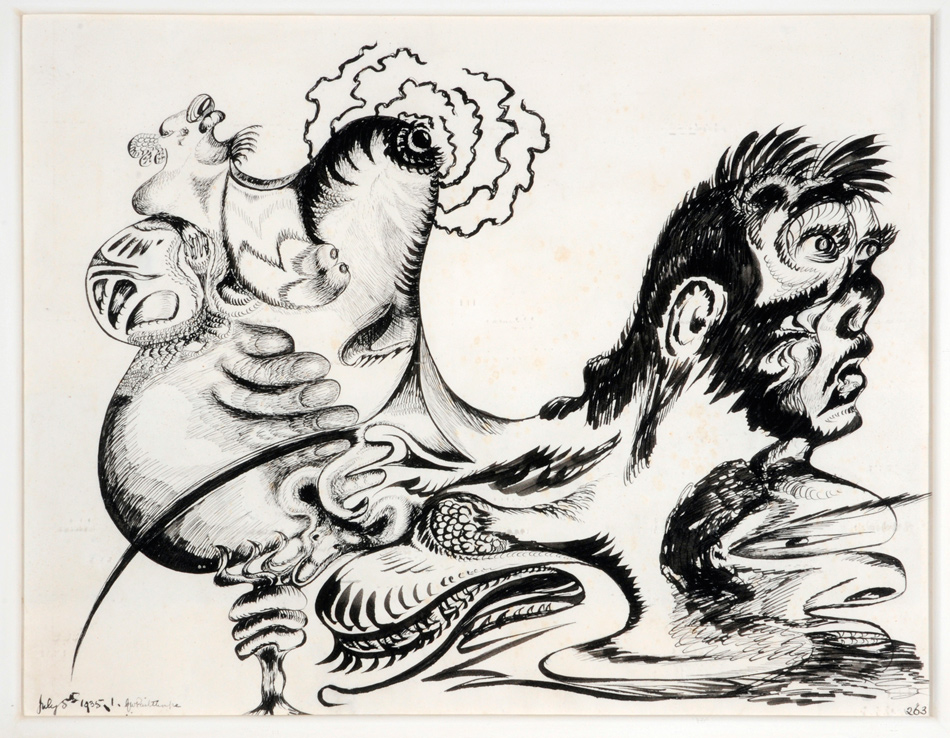“Drawing Surrealism” is an exhibition that puts us in two minds, which befits an art movement that sought the release of unconscious drives. The Morgan Library and Museum’s show, organized with the Los Angeles County Museum of Art, is one of the few major efforts ever to look at the wide range of drawings, collages, and other kinds of work on paper done both by well-known associates of Surrealism such as Joan Miró, Salvador Dalí, Max Ernst, and René Magritte and by the many other artists and writers drawn to the movement at the time. Including pictures made by figures from Eastern Europe, the Americas, England, and Japan, it is a jampacked, illuminating, and lavishly engaging event. Even before getting close to the drawings, which were made primarily from the middle of the 1920s into the 1940s, one is given the pleasure, simply in walking into the galleries at the Morgan, of seeing many smallish Surrealist works, sporting frames of every description, hung—as if in the living room of a knowing collector—in invitingly rhythmic ways.
On one wall, for instance, we find a cluster of drawings of heads by André Masson (a crisply linear robotic mask), Jacques Hérold (a softly grayed charcoal of a headlike shape suggesting fossils and woodlands), and Lee Mullican (meticulously drawn thorny leaves forming an armored visage). There are also an expansive John Graham drawing of a smiling and prepossessing woman with crossed eyes and a Pavel Tchelitchew drawing of a young man’s head with visible blood vessels everywhere turning his face into a jungle. Bringing together a group of heads may be an obvious idea. Here, though, where each work is subtly different in texture, tone, and size from the others, the effect is to kindle an interest in artists who are probably little known to most viewers.
The works in the show in general, however—especially as Leslie Jones, in her essay in its accompanying catalog, guides us through the meanings they held for these artists—were intended to be formally pathbreaking and imaginatively disorienting, even discomforting. Does this mean that the pictures have lost their sting and are items that we merely savor? To a degree, yes. On the other hand, the exhibition, in its informality and intimacy, gives Surrealism a freshness and excitement that an all-encompassing presentation of the art, which would include a huge variety of paintings and photographs—and the sometimes enigmatic and sometimes merely tacky sculptural pieces the Surrealists called “objects,” plus displays of the group’s many kinds of publications—might not achieve. At the current show we can almost believe we are encountering the movement for the first time.
Surrealism has entered the language as a synonym for almost anything that seems odd, uncanny, or freaky. For some, the very word connotes a profane, or carnivalesque, lifting of the lid on hidden, even repressed, thoughts and feelings. But initially this art was romantic and revolutionary in its goals. A little like Dada, which was more a spirit in the air than a movement, and probably put as much energy into cabaret performances and the issuing of statements as the making of artworks, Surrealism was about the need for radically new approaches to writing, art, and experience itself.
Dada was, in essence, an intendedly ephemeral rebuke of the society and conventions that had laid waste to Western Europe with the atrocities of World War I. Surrealism, which was underway already in the early 1920s in Paris, came out of the same disgust with the attitudes that resulted in the war. But where Dada flippantly said nothing mattered, Surrealism sought to find, foster, and celebrate precisely the impulses that traditional or generally accepted thinking seemingly said had no place at the table. It was after instinctive, irrational awarenesses, which might come from dreams, or from accepting results derived by chance—or from a receptivity to what is taboo—that could shake up and alter our sense of everyday reality.
Surrealism was in good measure the brainchild of André Breton, who had initially studied medicine and worked in psychiatric wards during the war. It was his background as a scientist of sorts that helped give the movement its character of an ever-changing, and always carefully monitored, experiment in living. Breton embodied a paradox of Surrealism. His role was to instigate and welcome the spontaneous, the illogical, and the inexplicable. His goal, it would seem, was to extend personal liberty. Yet he was a born guru and organizer with a flair for holding meetings, getting out position papers, marshaling his cohorts, and banishing the insubordinate. His efforts helped make Surrealism, as much as any movement of any era, a group endeavor.
Advertisement
Breton and his associates at times worked jointly on writing poems and, eventually, in making drawings. As Mary Ann Caws notes in her Surrealism (2004), a helpful compendium of artworks and writings related to the movement, group activities included “sleep séances to induce automatic speech while in a trance.” There were even meetings every day at six in the same café (they always lasted an hour and a half), and in the early 1930s everyone drank the same drink. (It was different in the winter and the summer.) The collective spirit didn’t, however, attest only to Breton’s need to control. Surrealism shared with Dada a desire to dispense with vaunted notions of authorship—with the aura, in the arts, surrounding training and mastery, uniqueness and the special, personal touch. These qualities were seen as components of the egotism that produced the war.
Although we may think that some of the deeper contributions of Surrealism are the paintings of Miró, Magritte, Dalí, and others, painting in itself was initially something of the enemy for many of the Surrealist (and Dada) artists. For figures who tended to be left-wing in their politics, oils on canvas were objects that all too easily could be seen as trophies of capitalism. Drawings, on the other hand, or anything done on paper, set down with any materials that were near to hand, suited a movement that in the beginning attracted writers as much as visual artists and that, opposed to artistic virtuosity for its own sake, saw in works on paper a way for anyone, trained or not, to record at the moment whatever was bubbling up from within.
At the Morgan’s exhibition, with its many different kinds of works on paper, we aren’t looking at artists who have necessarily forsworn painting. But many of them are being seen in the early stages of their working lives; and so Surrealism, it seems, is being encountered in a state of relative purity, even innocence. We are, in effect, at a testing ground both for seeing life in surreal, or upside-down, ways and for finding new ways to make art.
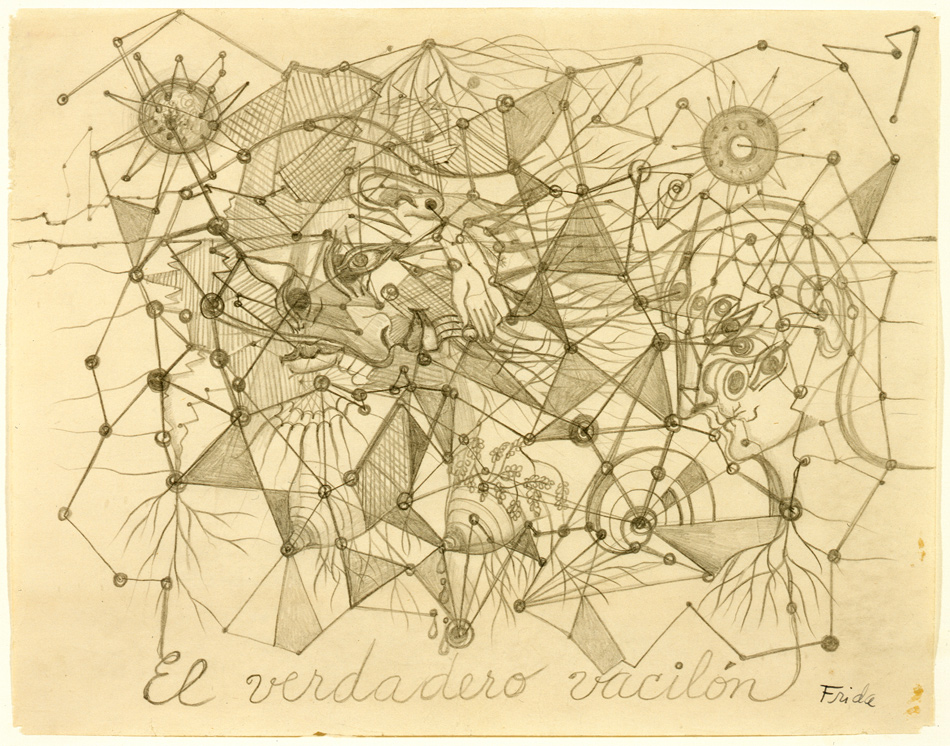
Private collection / Mary-Anne Martin Fine Arts, New York. © 2012 Banco de México Diego Rivera Frida Kahlo Museums Trust, Mexico, D.F. / ARS. Reproduction of Frida Kahlo governed by Instituto Nacional de Bellas Artes y Literatura
Frida Kahlo: El Verdadero vacilón (The True Vacillator), 8 1/2 x 10 3/4 inches, circa 1946-47
Surrealism’s chief artistic invention is probably the “exquisite corpse” drawing. It is created when a group of people pass around a piece of paper, and each participant, unaware of how the folded sheet has been handled by the previous person, adds his or her own contribution and sends it along. (The name “exquisite corpse” comes from a line in a poem that, made in the same group fashion, began with these words.) That most exquisite corpse drawings, including those in this exhibition, end up showing weird but not brilliantly weird standing figures has never dampened the game’s allure. The often could-be-better-next-time results may be why the Surrealists, we are told, found the game “addictive” and why we still like playing it.
The corpse drawings on hand are certainly no match for the other kinds of works on display. They include collages, automatic drawings—doodles, essentially, in which the doodler goes as far as he or she can—and calligrams, or word drawings, comprised solely of words, letters, or made-up words in a made-up script. There are works of frottage, formed by putting a piece of paper over a textured surface of some sort and rubbing it with a pencil, say, to bring up that surface. Another approach is called decalcomania. Here an inky medium is placed on a nonabsorbent piece of paper and then a clean sheet is pressed down on it. You pull up this sheet and you may get a mess or something inkily suggestive. Not least in this inventory are dream images, which include such traditionally drawn works as John Graham’s cross-eyed woman and Tchelitchew’s man with blood vessels. For many viewers dream images are what Surrealism is really about.
Attesting to the collective, or egalitarian, tenor of Surrealism (or simply reflecting the difficulty of obtaining loans), no one artist dominates the present show. Viewers of a 1993 exhibition called “Max Ernst: Dada and the Dawn of Surrealism,” which came to the Museum of Modern Art and showed the German artist to have been, especially during the years 1919 to 1922, around when he was turning thirty, one of the most inventive collagists who ever lived, will certainly wonder why, in this exhibition, he doesn’t stand out more. It was the Cologne-based Ernst—who sent Breton, in 1921, before Surrealism actually existed as a movement, some of the collages and drawings he had been making—who gave Surrealism some of the key elements of its identity.
Advertisement
Using photos from newspapers and engravings from catalogs and manuals and turning them, via seamless cutting and pasting (and sometimes coloring), into mesmerizing and rather confounding little stories of a kind, Ernst excited the Parisians because, reassembling materials he had found, he wasn’t, in the fullest sense, inventing his artwork himself. More than that, he was the first artist, I think, to connect the insouciant aspect of Surrealism (and of Dada) to a distinct body of images—and images that in an elusive yet persistent manner are about sexuality and can be nightmarish.
The collages by Ernst on view at the Morgan are merely all right. But he isn’t exactly missed, because there are a number of engaging and unfamiliar works on hand that are indebted to him. The Chilean painter Roberto Matta, for example, known for his enormous canvases showing planets or asteroids held in suspension, is seen here in a winning photocollage from 1936 with the very Surrealist title Wet Sheets. It presents the outer-space world he was always creating but minus the gauzily synthetic colors and textures that so often make his paintings less powerful than they ought to be. Even better, perhaps, is an outright humorous Ernst-like collage called The Chemist by Adriano del Valle, who was a Spanish poet. It shows the collage method to be an excellent way to illustrate someone in the process of losing his mind.
But probably every viewer of this show will come away with a highly particular group of favorites. My (long) list would include Minutes (1943), a tense, mysterious, and softly shaded pencil drawing by the little-known American painter Kay Sage that appears to show columns in a cathedral crowding one another to the point of airlessness. Yves Tanguy (who was married to Sage) makes an impact with an untitled 1936 work of decalcomania—a matter of voluptuous undulant pitch-black and grayed lines—that beautifully suggests the sea (his recurrent theme) at night. Grace Pailthorpe, an English psychiatrist, presents a vigorous and unhackneyed explosion of the id in Ancestors II (1935), in which waves surging this way and that become faces, teeth, fingers, and bodily swellings. And a Frida Kahlo drawing of a web of shapes stands out for having, on the bottom, in a large script, the wonderful title El Verdadero vacilón, meaning The True Vacillator.
Unlike anything in the exhibition, Dalí’s diaphanous 1938 pencil drawing Study for “The Image Disappears,” in which we see, depending on how it catches our eye, a man with a beard or a woman holding a piece of paper in her hand, is an especially impressive example of the double images he made on and off for a number of years. They are undeniably tricky (and they bother some viewers because it is hard, if not impossible, to see fully the two images at once). But for me the purely visual tension they create gives these pictures a formal strength that is not so different from the compositional power of a work by Mondrian. Asking us, moreover, to take in two different images almost simultaneously, they could be said to make concrete Surrealism’s quest, which in some way resembles the quest of psychotherapy, to find an alternative reality to the everyday one we think we are saddled with.
Surrealism remained a functioning movement of sorts until perhaps the early 1960s, or sometime before Breton died, in 1966. Its last real impact on art, though, probably came in the 1940s, when a number of American artists then finding their voices, including Jackson Pollock and Robert Motherwell, were stimulated by Surrealism’s belief that the unconscious was a reservoir of energies waiting to be tapped. An untitled Pollock drawing from around 1943 is the most dynamic and richly textured such tapping, or automatic drawing, in the show. It is a record of one disparate skirmish, as it were, after another that ends up having, remarkably, a breathing unity. It isn’t, in date, the last work in the exhibition, and it is not precisely a work of Surrealism, but it is a kind of fulfillment of an avenue of Surrealist thought.
This Issue
April 4, 2013
Controlling the Drones
Afghanistan: The Way to Peace


